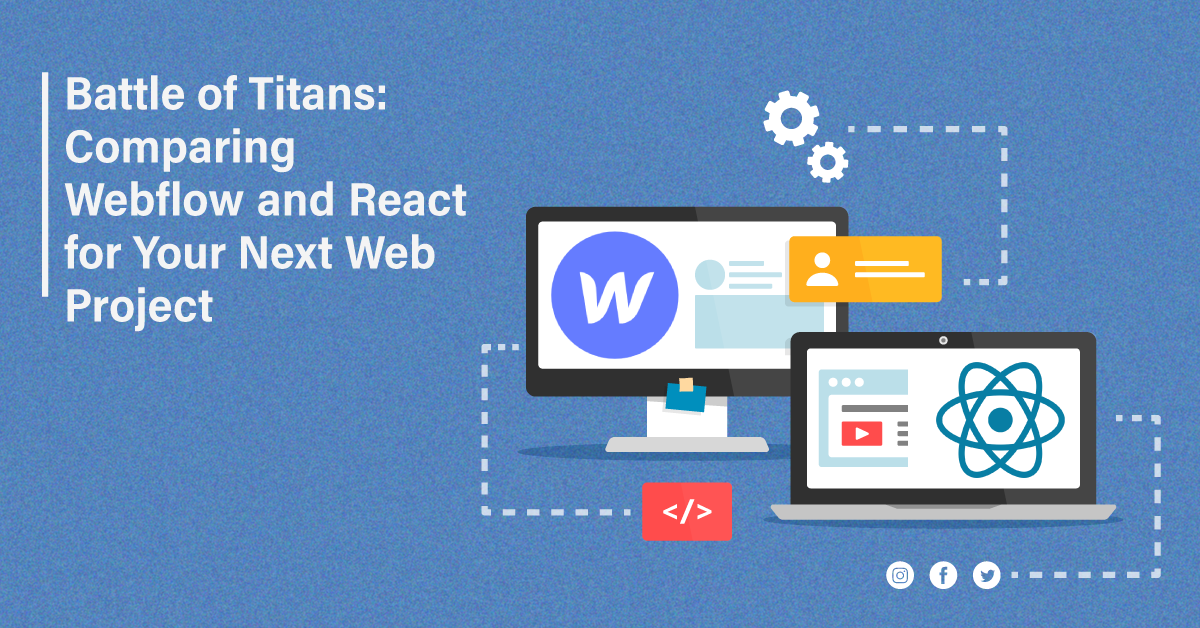The Boxes of Webflow and React
Nowadays in developing websites choosing the right tools and technologies can be a nerve-wracking task sometimes. But two prominent tools stand out as the best in the market that is; webflow and react. Each comes with its own set of strengths and capabilities that make it suitable for different types of projects and development workflows. React is a JavaScript library developed by Facebook for building user interfaces. It’s primarily used for creating interactive and dynamic web applications with a focus on reusable components. React allows developers to create UI components that represent different parts of a web application, and these components can be composed together to build complex user interfaces.
On the other side, webflow is a web design and development platform that allows users to create responsive websites visually, without needing to write code. It provides a powerful and intuitive visual editor that enables designers to design, prototype, and launch websites with ease. Both of these components have their unique strengths and capabilities. In this blog, we will be exploring nuances of webflow and react, along with its benefits and features that will help in developing the web project.
Understanding Webflow and React JS for web development
When it comes to web development, it is always important to select the right tools for creating web applications. Two tools make it a popular choice in the market; webflow and React. Webflow is a comprehensive web development and design platform that encourages users to create visually stunning websites and responsive websites without having to worry about writing a single line of code. The added key feature is that webflow allows designers to visually manipulate elements on the canvas like adjusting the layout, typography, and color in real-time web applications.
On the other hand, React.js, commonly referred to as React, is a JavaScript library for building user interfaces, particularly for single-page applications and dynamic web applications. The key added feature of React is that it encourages developers to break down their user interfaces into small and reusable components that promote reusability and maintainability.
Nuances between Webflow and React for Web Projects
Let’s now understand the difference between webflow and react for web applications. The first added advantage of webflow is that webflow’s visual editor allows users to design and develop websites without writing code. This makes it extremely accessible to designers and non-technical users. Also, with its intuitive drag and drop interface, webflow enables rapid prototyping and iteration that entirely facilitates quick design changes and experimentation. Furthermore webflow also offers built-in SEO features like customizable meta tags, clean HTML output, and automatic sitemap generation, to help improve search engine visibility. Besides, webflow encourages users to create responsive websites easily and always makes sure that it has a seamless experience across the various devices and screen sizes.
On the other hand, React offers a virtual DOM and efficient rendering mechanism to optimize performance by updating only the necessary parts of the UI, resulting in faster loading times and smoother user experiences. React’s JSX syntax allows developers to write HTML-like code within JavaScript, enabling a more expressive and intuitive way to create UI components. React has a vast ecosystem of libraries and tools, such as React Router for routing, Redux for state management, and Material-UI for pre-designed components, which enhance productivity and extend functionality.
Summary of the Topic; React and Webflow
Drawing the conclusion here, as we have seen webflow and react it offers a distinct advantage in web development. Webflow encourages various visual designs and enables a code-free creation of responsive websites, while React excels in dynamic user interface development. Webflow’s intuitive interface facilitates rapid prototyping and SEO features enhance discoverability. React’s virtual DOM ensures optimal performance and JSX syntax streamlines component creation. The choice between them depends on the project needs and the team expertise of the Reactjs development service company. Whether prioritizing design flexibility and ease with Webflow or diving into React for enhanced performance and functionality, developers can select the tool that aligns best with their goals and workflow.
